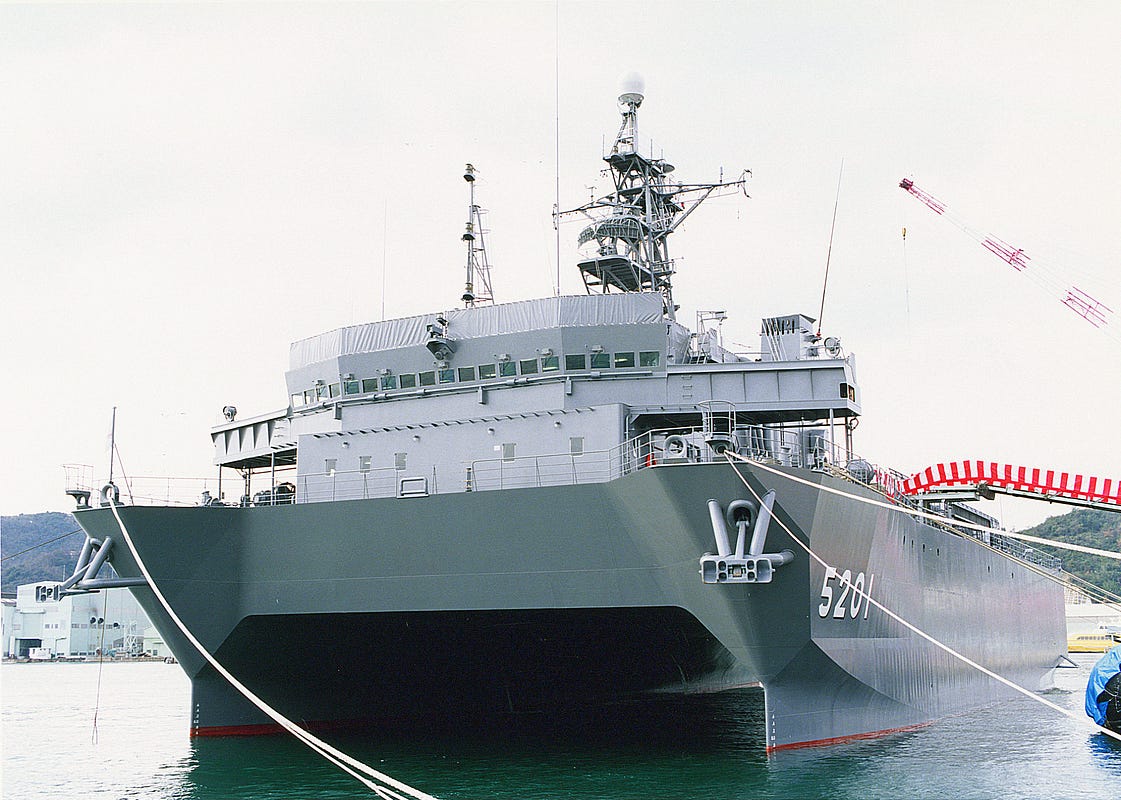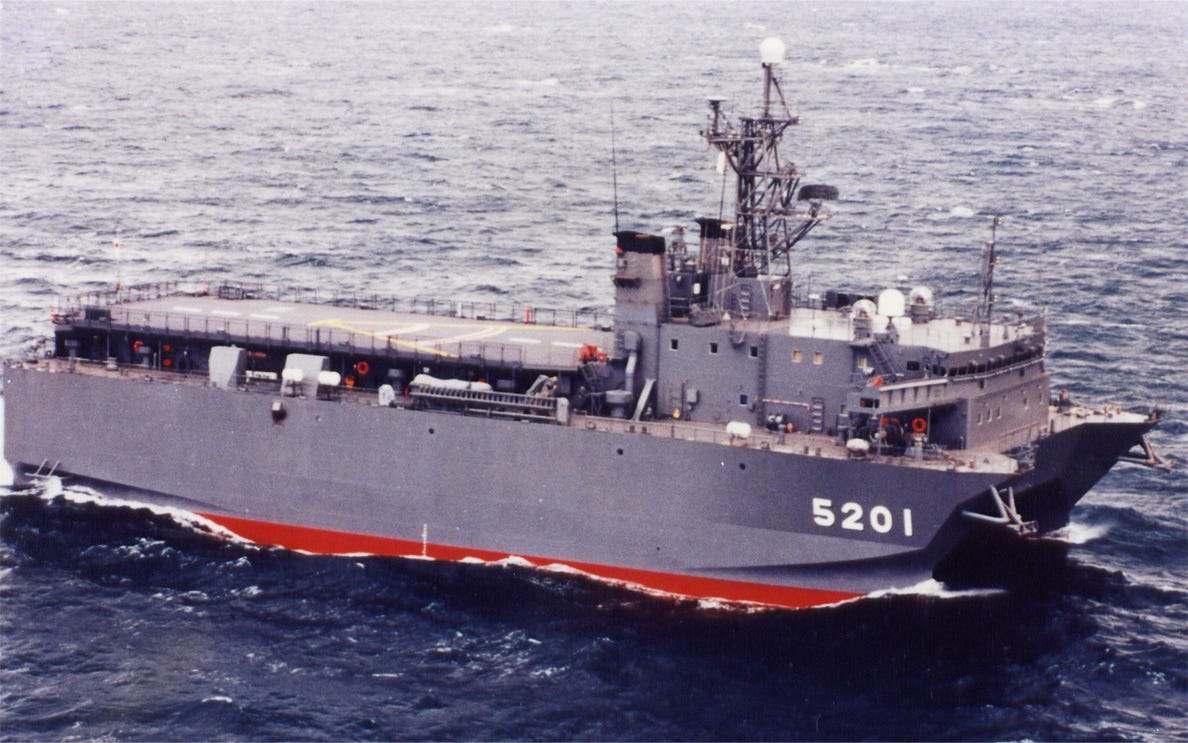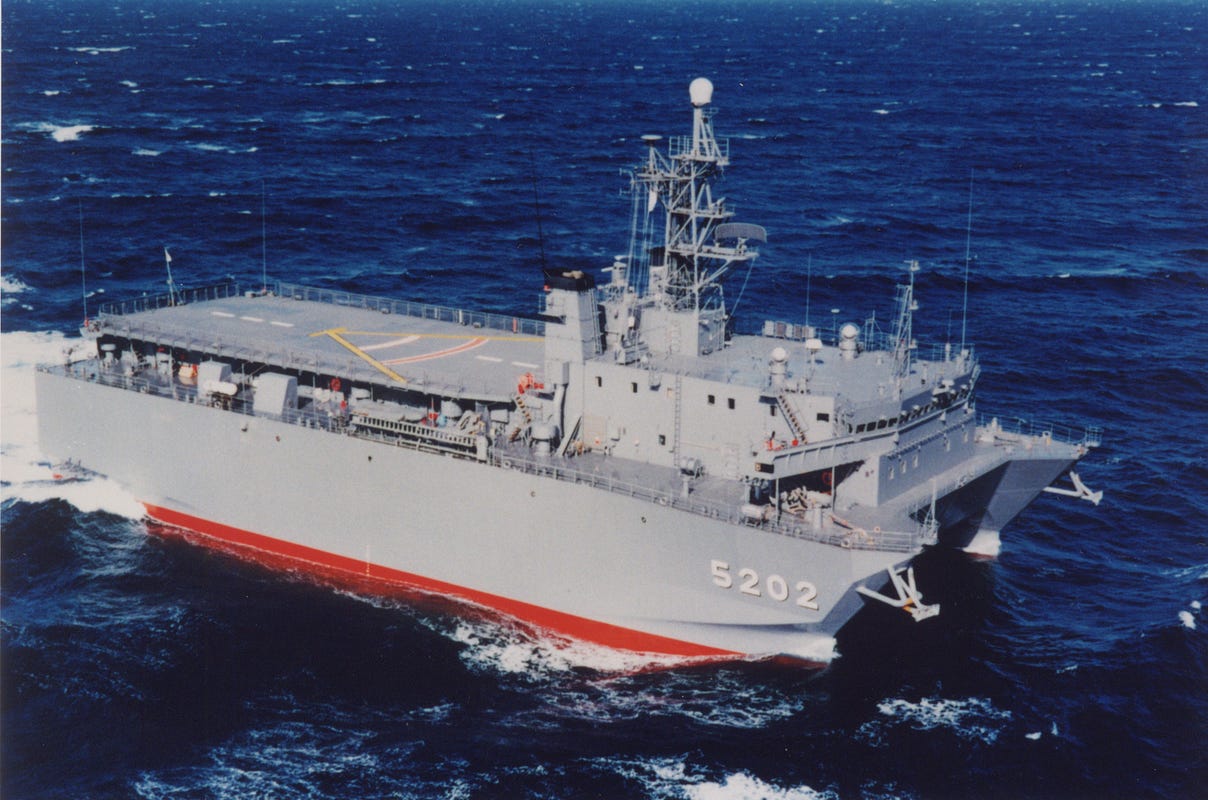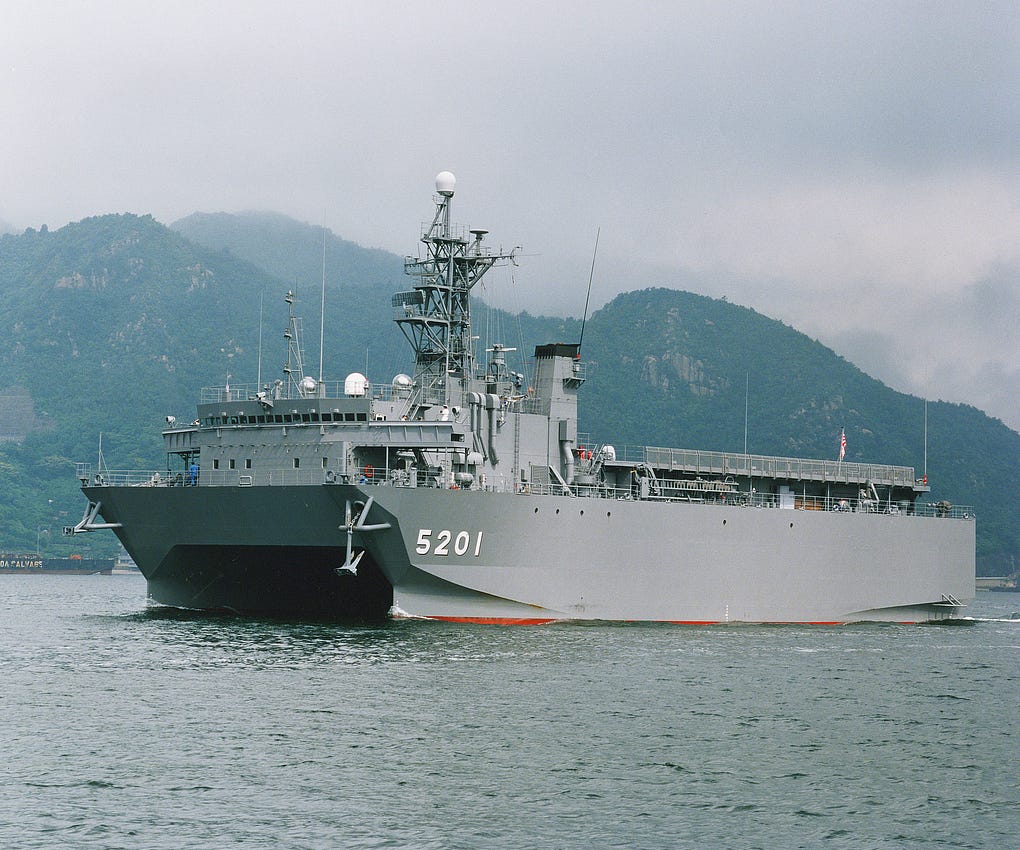July 5, 2014
Japan’s Ears on the Sea: The Cold War history of Japan’s unarmed ocean surveillance ships
James Simpson
War Is Boring
Strategically speaking, Japan’s expansive archipelago is a barricade. Japan’s near seas include many of the most important choke-points granting other countries access to the Pacific. Dominating these key straits is one of Toyko’s top priorities.
For this task, the Japanese Maritime Self-Defense Force’s two ocean surveillance vessels are particularly important. Hibiki and her sister ship Harima are mobile sonar listening stations that can track Russian and Chinese submarines in the seas around Japan.
Tokyo developedthe Hibiki class in response to the Soviet navy’s increasingly quiet submarines of the 1980s. The Soviet navy launched a new standard in silent runners—the Kilo-class hunter-killer submarines. These diesel-electric subs come covered in acoustic-absorbent anechoic tiles, significantly reducing their noise signature. They were so quiet that NATO naval personnel referred to them as “black holes.”
In 1988, there were as many as seven Kilo-class submarines operating in Japan’s backyard. These stealthy boats threatened Japan’s economic lifelines—its shipping lanes. Additionally, Japan’s northern frontier faces the Sea of Okhotsk, a sanctuary for Soviet nuclear missile subs.
Unseen and unheard by standard naval anti-submarine patrols, these underwater threats were nevertheless vulnerable to Japanese and American measurements surveillance, like Hibiki’s hydrophone arrays.
AOS 5201 Hibiki — the first in her class. Maritime Self-Defense Force photo
Acoustic measurement ships
Hibiki and Harima operate out of the major naval base in Kure, Hiroshima under the Maritime Self-Defense Force’s oceanographic command. Tokyo designates them as acoustic measurement ships, but their official English designation is “Ocean Surveillance Vessel.”
Unarmed, Hibiki and Harima are more like survey vessels than warships. They carry one of the most powerful sonar arrays in service—the AN/UQQ-2 Surveillance Towed Array Sensor System. Working alone and far from busy sea lanes, they unfurl long twin-line hydrophone arrays and patrol for months intently listening to long-range naval traffic.
Like much about Hibiki, SURTASS is American-made … and secret. Details of its effectiveness are classified, but SURTASS gained notoriety after environmentalists blamed its modern low-frequency active sonar component forkilling marine mammals.
Like the broadly similar American Victorious class surveillance ship, Hibiki has a hydrofoil-like design known as SWATH—small waterplane area twin hull. This strange configuration looks like two submarines supporting an oil rig. It places the bulk of the ship’s displacement under the surface of the sea, resulting in a more stable ride at low speeds.
Hibiki differs from its American counterparts at its rear. It has a large aft helicopter deck to allow for resupply flights during long voyages. The Hibiki class has a reported mission radius of 3,000 nautical miles and can patrol for 60 to 90 days at a time. Having the ability to take on supplies by helicopter gives Hibiki a major logistical advantage over its U.S. Navy cousins.
The first of its class, Hibiki officially takes its name from a stretch of open sea off the coast of Kyushu, but the officers who named her clearly had alternative meanings of the word in mind.
In Japanese, hibiki means “echo,” emphasizing the vessel’s use of reflected sound to map and track the location and movement of submerged ships. But the name has even more relevance. Hibiki was also the name of Japan’s first all-welded ship—a Fubuki-class destroyer turned over to the Soviet navy as a prize of war in 1947. Choosing this name for the new ship was a middle finger to the Soviet Union, the enemy Hibiki was designed to face.
AOS 5202 Harima. Maritime Self-Defense Force photo
Japan’s invisible enemy
American submarines wrecked havoc on Japan’s merchant fleet during World War II, leaving a deep impression on Japanese strategy. At the opening of the Cold War, this experience remained at the forefront of Tokyo’s defense plans.
The island nation was—and still is—heavily reliant on overseas trade. Transport vessels carried the essential food and fuel that powered the rebuilding Japanese economy. These crucial supplies would have been irresistible targets to Soviet subs in the event of a shooting war in East Asia.
While the postwar American security guarantee covered Japan’s shipping lanes, Tokyo doubted Washington’s willingness to act in a crisis. These fears fueled the Maritime Self-Defense Force’s growth into a strong independent navy capable of tracking Soviet submarines in the seas around the island nation.
Rather than being dismayed at Tokyo’s lack of trust, Washington encouragedJapanese naval development.
Japan’s strategic importance to American grand strategy lay in her proximity to the Sea of Okhotsk. Unable to beat the U.S. Navy in a straight fight, Soviet ballistic missile submarines retreated to naturally defensible bastions like the Okhotsk.
In the 1970s, the Soviet navy deployed Delta-class submarines carrying the R-29 ballistic missile. With a range of approximately 7,000 kilometers, the missiles could hit the U.S. West Coast from the safety of the Okhotsk bastion.
In addition, Soviet underwater traffic into the Pacific picked up starting in 1975. Moscow’s boats were deadlier, quieter and more numerous than ever. This worried Washington.
The U.S. pressured Japan to increase its defense budget in order to fund improvements in its anti-submarine capabilities. This pressure only increased after 1980, with Pres. Ronald Reagan’s inauguration and the Soviet invasion of Afghanistan.
 Hibiki owes everything to Washington’s desire for Tokyo to secure its own waters. Fearing abandonment and the Soviet underwater threat, in 1989 the Japanese Defense Agency introduced plans for a new 2,800-ton acoustic surveillance ship.
Hibiki owes everything to Washington’s desire for Tokyo to secure its own waters. Fearing abandonment and the Soviet underwater threat, in 1989 the Japanese Defense Agency introduced plans for a new 2,800-ton acoustic surveillance ship.
The Hibiki class has a SWATH design. Maritime Self-Defense Force photo
American brain in a Japanese body
While Japan built the ship’s hull, Hibiki’s tech is all American. The U.S. Navy had already proven the effectiveness of SURTASS in the Stalwart-class before Hibikientered service. The hydrophonic surveillance system remains the most sophisticated mobile anti-submarine listening device in service today.
After Hibiki entered service, Tokyo sent her to the U.S., where Washington paid for the fitting of the vessel’s SURTASS sonar system. In addition to ongoing financial support, the U.S. Navy reportedly supplies five technicians per ship. These civilian operations personnel work for the U.S. Navy’s Space and Naval Warfare Systems Command.
Washington’s involvement with the Hibiki class is no secret. Department of Navy annual budget estimates refer to them as “Japanese Auxiliary Ocean Surveillance” ships.
These reports state that the Japanese and U.S. governments each pay half of the costs of operating SURTASS on these vessels. The funding includes money for training and upgrades such as the two ships’ new twin-line arrays which improve their effectiveness in shallow waters. The Hibiki class thus costs the American taxpayer around $10 million a year.
The funds also provide for a shore site—the Anti-Submarine Warfare Operations Center in Naha, Okinawa. The ships send their recordings to the center via the U.S. military’s Defense Satellite Communications System. The center matches the data against its database of hydrophone recordings to identify submarines and track their positions.
The funding buys Japan’s direct and immediate contributions to U.S. naval intelligence-gathering efforts. It ties Japan into the Integrated Undersea Surveillance System—the U.S. Navy’s global submarine tracking network. This network of mobile and stationary listening assets include America’s own surveillance ships, one of which is based out of Japan at the Yokohama North Dock.
The Hibiki class is a Cold War symbol of the U.S.-Japan alliance. Like the alliance, the ships have survived the Cold War intact—even if ambitions for a third vessel have faded. Japan’s 2011 Mid-Term Defense Program review cancelled the longstanding plan and it seems unlikely that Japan will ever build the third ship.
The Hibiki class remains relevant to Japan’s post-Cold War defense plans. Maritime Self-Defense Force photo
From Russia to China
Even if the money isn’t there for a new ship, Japan’s submarine problem remains.
China has a growing fleet of submarines consisting of five nuclear attack submarines, four nuclear ballistic missile submarines and 53 diesel attack submarines. These attack submarines include Russia’s improved Kilo class and China’s own superior Yuan class.
Chinese ships regularly cruise through Japanese-controlled straits. In May 2013, the Japanese Defense Ministry publicized three submarine sightings in the contiguous zone that spans the Japanese archipelago. While this zone is not Japan’s territory, Japan has exclusive economic control of the waters 12 to 200 miles from its shores.
In November 2004, a submerged Chinese nuclear submarine navigated Japan’s territorial waters. Under international law, submarines should surface and fly their nation’s flag when in another country’s territory. Submerged submarines signal belligerence.
China sends its submarines to observe Japanese and American naval exercises in Japan’s seas. In October 2006, a Song-class submarine surfaced within five milesof the aircraft carrier USS Kitty Hawk.
The submarine was running on air independent propulsion and batteries, which makes it almost silent. The incident stoked fears that Chinese naval advances might threaten American supremacy in the Pacific. It was yet another example to Japan of China’s dangerous confrontational attitude at sea.
China is now building a solid second-strike capability. The U.S. Naval Institutereports that Jin-class nuclear-powered submarines will begin patrolling thenorthern Pacific this year. They will carry Ju Lang 2 ballistic missiles with a range of 4,000 nautical miles—putting them within striking distance of the continental United States.
In response, Japan’s 2013 defense guidelines emphasize increasing its submarine force and strengthening its anti-submarine warfare capabilities. This still does not include building a new ship in the Hibiki class, but these cold warriors are still the most effective long-range naval surveillance means available to Japan.
Thanks to continuing American upgrades and training, Hibiki and Harima still man the eastern gates of the Pacific.



No comments:
Post a Comment